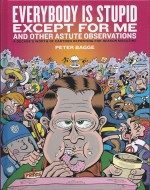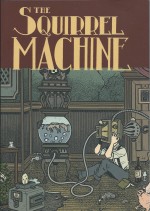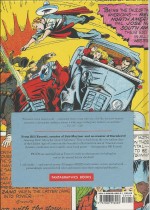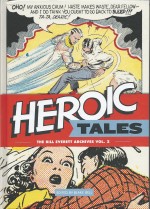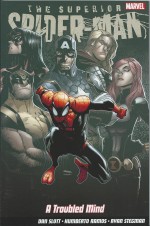
By Irwin Chusid & Barbara Economon (Fantagraphics Books)
ISBN: 978-1-60699-655-3
Some artists can be said to epitomise an era, their works forever evoking the time and style and flavour of a discreet age. Usually it’s all those inspired invisible creatives toiling at the coalface of imagination: advertising and package designers, film poster artists, fashion designers and yes, comic and strip illustrators, whose individual yet socially synergistic efforts pool and leak into a generation’s psyche.
A very select few artists can be also be charged with actually creating the definition of an epoch: Jim Flora was one of those…
Born in Ohio in 1914, he studied at the Art Academy of Cincinnati from 1935-1939. A year before he graduated Flora met brilliant but troubled author and artist Robert Lowry and together they founded the influential Little Man Press, publishing a stellar line of impressive literary titles with eye-catching art and design.
In 1942 they parted and Flora, newly married, briefly became a freelance artist before taking a job with Columbia Records. He upped sticks for Westport Connecticut, initially working for the in-house art department under Alex Steinweiss (inventor of the illustrated album cover).
The newcomer designed ads, crafted and illustrated new-release pamphlets and assorted retail trade literature, but when his boss enlisted in the Navy, the 4-F Flora was promoted to Art Director.
Always drawing and designing, he continued until 1945, creating the groundbreaking advance-trade periodical Coda, and was promoted to Advertising Manager. However, afflicted with an insatiable hunger to create, Flora chafed in such a time-consuming, bureaucratic position, even as his first landmark LP designs began to appear throughout 1947.
Despite having a wife and five kids to support, in 1950 he resigned and relocated with the brood to Mexico for 15 months. Despite revelling in artistic freedom and absorbing the colourful kinetic art of the region, the Floras returned to Connecticut in 1951, and Jim began a hugely successful career as a freelance illustrator. Thereafter he lent his uniquely enchanting style to record covers for Columbia, RCA Victor, Camden and others whilst generating mountains of illustrations for books, newspapers and magazines.
Life, Look, Newsweek, The New York Times Magazine, Fortune, Holiday, Mademoiselle, Research and Engineering, Computer Design Magazine, Sports Illustrated, Collier’s and many others numbered him amongst their regular contributors, and for most of 1952 he also operated as Art Director for Park East, where he published the earliest commercial art of R.O. Blechman and Andy Warhol.
His tireless creativity and graphic invention always forcing him into new challenges, Flora also created storyboards for animator Gene Deitch at cartoon factory United Productions of America (UPA).
He was also a savvy professional and could see how times and trends would inevitably shift. With fashion inexorably against him, Rock ‘n’ Roll supplanting Jazz and classical sounds and photography encroaching on album sleeves, in 1955 he sold his first illustrated children’s book The Fabulous Fireworks Family to Harcourt Brace, and produced sixteen more until retirement in 1982.
He loved everything nautical or maritime and cherished Jazz, and his pervasive, infectious style transformed animation and graphic illustration from the late1950s on, when all those kids who’d bought his LP covers or read his publicity bulletins began to work on cartoons for the burgeoning, all-consuming television industry or entered the advertising field.
Flora was addicted to making art and employed a uniquely frenetic, narrative-packed rhythmic style that jumped with boundless energy and charm and paid no-nevermind to foolish hobgoblins like perspective, representational anatomy or good taste and common sense. Many of the most impressive works abound with wry but subtly concealed scenes of horror, sex and violence…
Flora never drew comics, but if he had they would have been amazing…
This superb coffee-table art book by biographers, archivists and fans Irwin Chusid and Barbara Economon is the fourth compilation in a series that includes The Mischievous Art of Jim Flora (2004), The Curiously Sinister Art of Jim Flora (2007) and The Sweetly Diabolic Art of Jim Flora (2009). As such it contains hundreds of beguiling and revelatory images, roughs, sketches, photos, designs, layouts, complete ads and spot illustrations from his most productive decades: images impossibly familiar and nostalgia-loaded for anyone who grew up in the 1960s and 1970s.
Most importantly this book also reproduces every (known) record cover Flora created…
It all opens with Chusid’s expansive biographical overview ‘Wizard of the Square-Foot Canvas’ and includes an ‘Interview with Jim Flora’ plus Martina Schmitz’ ‘Interview with Robert Jones’ (lifelong buddy and Flora’s Art Director successor at Columbia, RCA Victor and Park East, he commissioned a vast number of works from the freelancer), all liberally bedecked with stunning pictures.
The colossal Album Covers gallery then commences to steal your visual breath away presenting stunning reproductions of those eccentric masterpieces from Mambo For Cats to The Dukes of Dixieland, Strollin’ the Cha Cha Cha to Inside Sauter-Finegan, from Lord Buckley’s Hipsters, Flipsters, and Finger-Poppin’ Daddies Knock Me Your Lobes to Mexican Folk Songs or Till Eulenspiegel to For Boppers Only, concluding with a groovy selection of his commercial art spreads and later fine art pieces – paintings, drawings and prints celebrating music, friends and life.
His influence on generations of artists is incalculable and lasting. Flora passed away in 1998, but his pictures are still here, frantically jinking and jiving in every mind that ever saw them…
The High Fidelity Art of Jim Flora © 2013 Irwin Chusid. All images © the Heirs of Jim Flora, except where noted otherwise. All rights reserved.
Win’s Christmas Gift Recommendation: a pictorial time-warp for hepcats of all ages… 8/10





